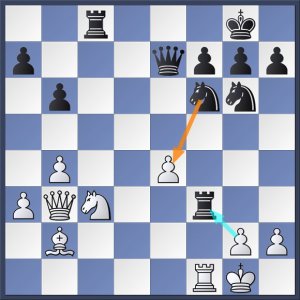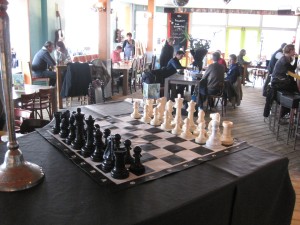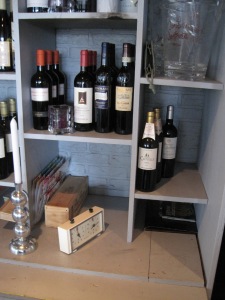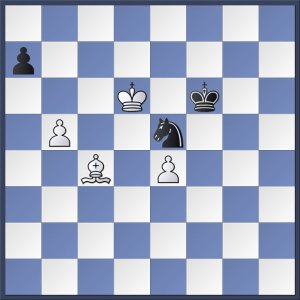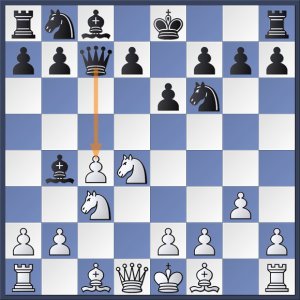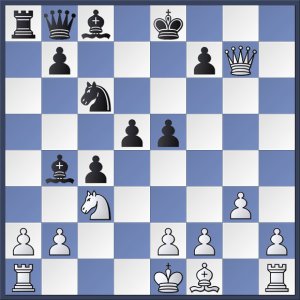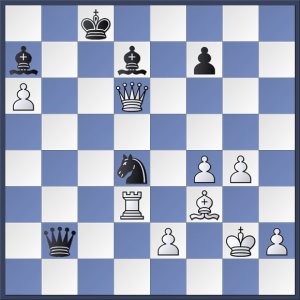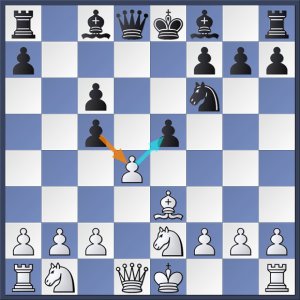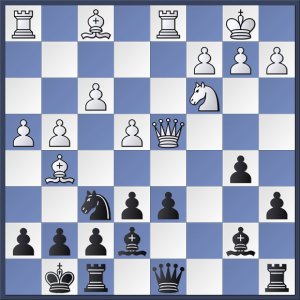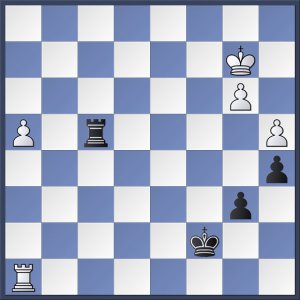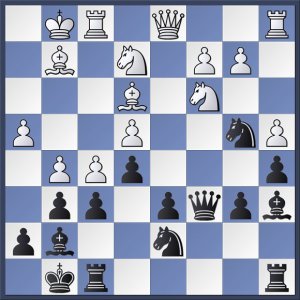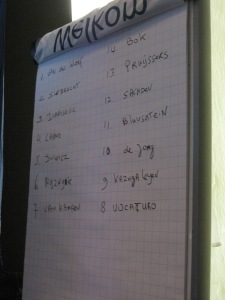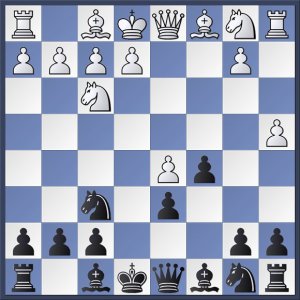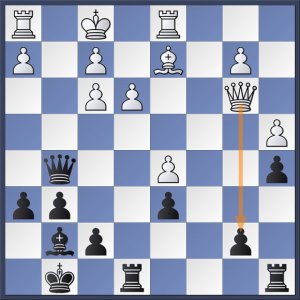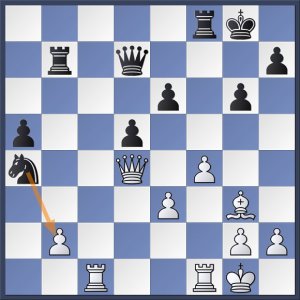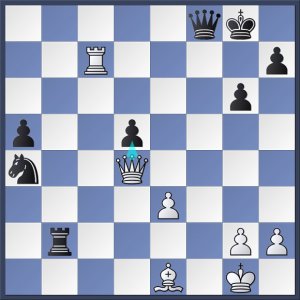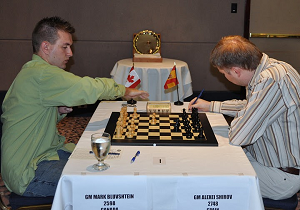Rounds 1-4: 0-1
February 26, 2011 5 Comments
I reached Moscow on February 6th, a couple of days before the start of the tournament. I was hoping that my week break in Brussels between the tournaments would give me some energy. I was excited about the strength of the tournament because it’s hard to find it anywhere else.
It was nice to see relatives that I haven’t seen since 2005 upon my arrival. A nice dinner with them was a good start to the trip. I also knew that some Canadians would take part in the tournament. Canada’s newest Grandmaster, Thomas Roussel-Roozmon, would also play in my section. Antoine Berube would play in the B-Group. Victor Plotkin of Toronto would play in the C-Group. Canadian Doug Sly also played in the C-Group.
The tournament took place in the Izmailovo Complex. Those who have never traveled to Moscow might be shocked by the atmosphere. People smoke anywhere. Restaurants, hallways, washrooms and other indoor places appear to be fair game. For the Canadians, this was not too pleasant.
One of the only bright spots of the tournament was the high level of players in the A-Group. I knew I would be paired up in the first round and there would be no easy games. Time for the action. Photos and other descriptions to come in a later post.
Round 1
I was paired against GM Andreikin, rated 2689. Andreikin is a 20 year old who is close to making it to the Elite. I haven’t played a player this high rated since Corsica.
[Event “?”]
[Site “?”]
[Date “2011.02.08”]
[Round “?”]
[White “Bluvshtein”]
[Black “Andreikin”]
[Result “0-1”]
[ECO “A00”]
[PlyCount “66”]
[EventDate “2011.02.08”]
[SourceDate “2011.02.08”]
1. d4 Nf6 2. c4 e6 3. Nc3 Bb4 4. e3 O-O 5. Nge2 d5 6. a3 Be7 7. Ng3 c5 8. dxc5
dxc4 9. Qc2 Qa5 10. Bxc4 Qxc5 11. Bd3 Nbd7 12. O-O Ne5 13. Be2 b6 14. f4 Ng6
15. b4 Qc7 16. Bb2 Bb7 17. Rac1 Rac8 18. Qb3 Qb8 19. f5 exf5 20. Nxf5 Bd6 21.
Nxd6 Qxd6 22. Rf2 Qe7 23. Bf3 Bxf3 24. Rxf3 Rfd8 25. Rcf1 Rd3 26. e4 Rxf3 27.
Rxf3 Ne5 28. Rg3 Qd6 29. Nb5 Qd2 30. h3 Nh5 31. Rc3 Rd8 32. Kh2 h6 33. Qc2 Nf3+
0-1
1. d4 Nf6 2. c4 e6 3. Nc3 Bb4 4. e3 O-O 5. Nge2 d5 6. a3 Be7 7. Ng3 c5 8. dxc5 dxc4 9. Qc2 Qa5 10. Bxc4 Qxc5
This is where I started to go wrong. 11. Bd3? An innocent looking move, but a mistake nonetheless. 11.Be2 was more appropriate. The Bishop is better placed on e2 because it does not fall under attack after black eventually plays Ne5 and it has easier access to f3. Added to this, it closes the d-file from d3. All this being said, I expected my opponent to put his knight on e5 and I had my own intentions. 11… Nbd7 12. O-O Ne5 13. Be2 b6 14. f4?! This is the aggressive intention I had in mind with my 11th move. However, I should have preferred the more subtle 11.b4 Qc7 12.Bb2 with simple development and a position that is about equal. I decided to force the issue. 14… Ng6 15. b4 Qc7 16. Bb2 Bb7 17. Rac1 Rac8 18. Qb3 Qb8 19. f5 The break that I was aiming at all along. I felt that the activity of my pieces would compensate for the worse pawn structure. 19… exf5 20. Nxf5 Bd6
Black has been playing very logically and now attempts to create problems with his two sharp shooting Bishops. 21. Nxd6 21.g3 or 21.h3 are not too appealing when thinking about the long-term safety of my King. 21… Qxd6 This was a critical moment. I felt that the two Bishops should be giving me sufficient play, but my e3 pawn is a horrible weakness and I might have some future problems with the safety of my King. My Queen on b3 is poorly placed as well. The logical 22.Nb5 is punished by 22…Qd2. 22. Rf2 The correct solution was 22.Rcd1 Qe5 23.e4!? Nxe4 24.Nxe4 Qxe4 25.Rf2, where White gives away the pawn but his pieces are firing on all cylinders. Suddenly, the position is not easy to play for Black. 22… Qe7 23. Bf3 Bxf3 24. Rxf3 Rfd8 25. Rcf1 Rd3 26. e4 Rxf3
27. Rxf3 It’s always hard choosing the lesser of two evils. Chess is no exception. 24. gxf3 was an interesting alternative, where White does not have to worry about the e4 pawn but has to change his attention to the safety of his King. 27… Ne5 28. Rg3? After games like these, it’s hard to explain to myself as to why I chose the g3 square for my rook instead of the far more logical f1 square. I had underestimated my opponent’s reply. 28… Qd6! 29. Nb5 Qd2 30. h3 Nh5 31. Rc3 The losing move, 31.Bxe5 Qe1+ 32.Kh2 Rc1 33.Rxg7 Nxg7 34.Qd3 would have left white with some hope.
31… Rd8! White is left with no moves 32. Kh2 h6 With less than a minute remaining on the clock to find a move that did not exist, I lost on the spot. 33. Qc2 Nf3+ 0-1
Well played game by my opponent. For the first time in a while, I felt the strength of my opponent. I was punished for my mistakes with full force. A very well executed game by Black. I need to put up better resistance. My aggression in the opening backfired after some accurate moves by my opponent.
Round 2
I was paired against WGM Pogonina in this round, rated 2472 and ranked #27 on the Women’s rating list (far higher than Andreikin’s 47th seed for both genders). I wanted to put pressure on my opponent early on in the game and did just that in the opening.
[Event “?”]
[Site “?”]
[Date “2011.02.09”]
[Round “?”]
[White “Pogonina”]
[Black “Bluvshtein”]
[Result “0-1”]
[ECO “A00”]
[PlyCount “124”]
[EventDate “2011.02.08”]
[SourceDate “2011.02.08”]
1. e4 d6 2. d4 Nf6 3. Nc3 g6 4. Be3 a6 5. a4 Bg7 6. h3 O-O 7. Nf3 b6 8. Bd3 Bb7
9. O-O Nbd7 10. Qd2 e5 11. Bh6 exd4 12. Nxd4 Nc5 13. Rfe1 Re8 14. Bxg7 Kxg7 15.
Qf4 Nh5 16. Qg4 Qf6 17. Nf3 Nf4 18. Re3 Nfxd3 19. cxd3 Ne6 20. Rae1 c5 21. R3e2
Bc6 22. Nd5 Bxd5 23. exd5 h5 24. Qc4 Nc7 25. Rxe8 Rxe8 26. Rxe8 Nxe8 27. Qb3
Qf4 28. Qc4 Qf6 29. Qb3 Qf4 30. Qxb6 Qxa4 31. d4 c4 32. Kh2 Qb5 33. Qd8 Kf8 34.
Qc8 a5 35. Nd2 Qxb2 36. Nxc4 Qxf2 37. Nxa5 Qxd4 38. Qa8 Qe5+ 39. Kh1 Qe4 40.
Nc6 Qxd5 41. Qc8 Qe6 42. Qd8 Kg7 43. Qh4 d5 44. Qd4+ Nf6 45. Ne5 Qf5 46. Nf3
Kh7 47. Ne5 Nd7 48. Nf3 Kg8 49. Kg1 Qe4 50. Qb2 Nf8 51. Qb8 g5 52. Qg3 Qe3+ 53.
Kh1 Ne6 54. Qd6 d4 55. Ne5 Qc1+ 56. Kh2 Qf4+ 57. Kg1 g4 58. hxg4 hxg4 59. Qb8+
Kg7 60. Qb5 g3 61. Nd3 Qe3+ 62. Kf1 Nc5 0-1
1. e4 d6 2. d4 Nf6 3. Nc3 g6 4. Be3 a6 5. a4 Bg7 6. h3 O-O 7. Nf3 b6 8. Bd3 Bb7 9. O-O Nbd7 10. Qd2 e5
We reached a standard position out of the Pirc. White has not played ambitiously and does not have an advantage 11. Bh6?! White should not aim to exchange this Bishop. 11… exd4 12. Nxd4 Nc5 13. Rfe1 Re8 14. Bxg7 Kxg7 15. Qf4 Nh5 Trying to create white some problems and also forcing the Queen to choose a square. 16. Qg4 Qf6 Black has grabbed the initiative. 17.Nf5 Kh8 does not bring any good to White’s position. The Queen is awkwardly placed on g4. 17. Nf3
17… Nf4 The simple 17…Bc8 18.Qg5 Qxg5 19.Ng5 Bb7 would have given Black good prospects as White has to worry about her e-pawn in the near future. 18. Re3! I underestimated this move and reacted in a forcing manner. 18… Nfxd3 18…Bc6 would have kept White under pressure. 19.Nh4 Kh8 20.Rf3 g5! would not be good for white. 19. cxd3 Ne6 20. Rae1 c5 21. R3e2 Bc6 21…Rad8 was more accurate, where I would not have to trade both pairs of rooks after 22.Nd5. 22. Nd5 Bxd5 23. exd5 h5 24. Qc4 Nc7 25. Rxe8 Rxe8 26. Rxe8 Nxe8 I went into this endgame thinking that Black is not risking anything. That is the correct evaluation. 27. Qb3 27.d4! Nc7 28.dxc5 bxc5 29.Qb3 would have equalized. 27… Qf4 28. Qc4 Qf6 29. Qb3 Qf4
Interesting little dance. It looks like we have been repeating moves and it’s not easy for either side to play for a win. As I found out with White’s next move, both players want more than just half a point. 30. Qxb6? 30.Qc4 would have been answered with 30…g5!, where Black is still the one objectively fighting for a win. 30… Qxa4 White’s double d-pawns guarantee some suffering. 31. d4 c4 32. Kh2? White is already on the ropes but something similar to 32.Qc6 Qb5 33.g3 was necessary to try to hold on. 32… Qb5! 33. Qd8 Kf8! Black is winning at least a pawn. 34.Ng5 is answered with the calm 34… Qxg5 35.Nh7+ Kg7. 34. Qc8 a5 35. Nd2 Qxb2 36. Nxc4 Qxf2 37. Nxa5 Qxd4 38. Qa8 Qe5+ 39. Kh1
White is down a pawn and all her pieces are awkwardly placed. 39… Qe4 One of the winning moves. White cannot untie without losing the d5 pawn. 40. Nc6 Qxd5 The rest is easy. 41. Qc8 Qe6 42. Qd8 Kg7 43. Qh4 d5 44. Qd4+ Nf6 45. Ne5 Qf5 46. Nf3 Kh7 47. Ne5 Nd7 48. Nf3 Kg8 49. Kg1 Qe4 50. Qb2 Nf8 51. Qb8 g5 52. Qg3 Qe3+ 53. Kh1 Ne6 54. Qd6 d4 55. Ne5 Qc1+ 56. Kh2 Qf4+ 57. Kg1 g4 58. hxg4 hxg4 59. Qb8+ Kg7 60. Qb5 g3 61. Nd3 Qe3+ 62. Kf1 Nc5 0-1
This was an important win. Going into this round I knew that I had lost my last 3 games with Black against 1.e4. I didn’t think too much of it and went back to the Pirc. After getting a good position out of the opening I played with some uncertainty in the middle game as I didn’t capitalize on my opponent’s mistakes. I played the endgame with a lot of precision.
Round 3
With 1/2 points I was paired against GM Vitiugov, rated 2709. I knew my opponent was as strong as they come. I was looking forward to the challenge. I also expected that my Nimzo would be tested once again by a top level player.
[Event “?”]
[Site “?”]
[Date “2011.02.10”]
[Round “?”]
[White “Bluvshtein”]
[Black “Vitiugov”]
[Result “0-1”]
[ECO “A00”]
[PlyCount “72”]
[EventDate “2011.02.08”]
[SourceDate “2011.02.08”]
1. d4 Nf6 2. c4 e6 3. Nc3 Bb4 4. Nf3 b6 5. Qb3 a5 6. Bg5 h6 7. Bh4 Bb7 8. e3
Nc6 9. Bd3 a4 10. Qc2 a3 11. b3 Be7 12. O-O O-O 13. Qd2 Nb4 14. e4 d5 15. Bxf6
Bxf6 16. e5 Be7 17. Rfe1 dxc4 18. bxc4 Bxf3 19. gxf3 Bg5 20. Qd1 Bf4 21. Ne2
Nxd3 22. Qxd3 Bxe5 23. Rad1 Bd6 24. f4 Ra5 25. Kh1 Qf6 26. Rg1 Bxf4 27. Rg4 Bd6
28. f4 Rd8 29. Ng3 Bxf4 30. Qf1 Bg5 31. Qg2 Qe7 32. d5 f5 33. Rgd4 Rf8 34. d6
cxd6 35. Rxd6 Re5 36. Qf3 Re1+ 0-1
1. d4 Nf6 2. c4 e6 3. Nc3 Bb4 4. Nf3 b6 5. Qb3 a5 6. Bg5 h6 7. Bh4 Bb7 8. e3 Nc6
Everything has been pretty standard up to this point. White has more space and comfortable placement of his pieces. Black has a hidden idea. 9. Bd3? Missing the significance of my opponent’s idea. 9.a3 a4 10.Qc2 Bxc3 11.Qxc3 would have offered white good chances for an advantage. 9… a4 10. Qc2 a3! With the pawn on a3 Black will always have some play on the queen side. White can’t say the same. The idea looks harmless at first but is positionally strong. 11. b3?! Better was 11.0-0!, allowing Black to increase White’s number of pawn islands but still opening the position in a way that would make sense for White’s pieces. 11… Be7 12. O-O O-O 13. Qd2 Nb4
14. e4 Still trying to play for the advantage. It is hard to meet Black when he plays d5 and c5 with easy play for him. Now it becomes clear that the fixed a2 pawn and the possession of the b4 square for the Knight is unpleasant for White. I chose the active plan. 14… d5 Black creates concrete problems for White to solve. This is where I start collapsing. 15.exd5 exd5 16.Rfe1 dxc4 17.bxc4 maintains roughly a balanced position. 15. Bxf6 Bxf6
White needs to play precisely to hold on. 16. e5 Be7 17. Rfe1? White’s position is very difficult after this move. 17.Be2 was necessary to better connect the White pieces. 17…dxc4 would be answered with 18.bxc4 c5 19.Nb5. 17… dxc4 18. bxc4? The position is close to resignable after this move. 18.Bxc4 would offer better resistance but Black is clearly better after 18…c5. 18… Bxf3 19. gxf3 Bg5! I did not realize how strong this idea is. 20. Qd1 20.f4 Nxd3 is just down a pawn. 20…Bf4! Black’s Queen is ready to get in on an attack.
21. Ne2 Nxd3 22. Qxd3 Bxe5! Black is up a pawn and has a far superior pawn structure. I try to complicate the matter with “hopes” of an attack but the outcome is never in doubt. 23. Rad1 Bd6 24. f4 Ra5 25. Kh1 Qf6 26. Rg1 Bxf4 27. Rg4 Bd6 28. f4 Rd8 29. Ng3 Bxf4 30. Qf1 Bg5 31. Qg2 Qe7 32. d5 f5 33. Rgd4 Rf8 34. d6 cxd6 35. Rxd6 Re5 36. Qf3 Re1+ 0-1
A disappointing loss. Losing to stronger opposition is a big part of learning. There are different ways to lose to good players though. In this game, much like in round 1, I just collapsed under pressure. There was not much of a battle. I know I can play better and this was the disappointing part. I made it easy for my opponent. The good thing is that I was to play Black next (I have never said that before).
Round 4
I was paired against another female player, in 19 year old up and coming WGM Wenjun Ju, rated 2514. My opponent surprised m as early as the first move with an uncommon (for her) 1.c4.
[Event “?”]
[Site “?”]
[Date “2011.02.11”]
[Round “?”]
[White “Ju, Wenjun”]
[Black “Bluvshtein”]
[Result “0-1”]
[ECO “A00”]
[PlyCount “92”]
[EventDate “2011.02.08”]
[SourceDate “2011.02.08”]
1. c4 e5 2. Nc3 Nf6 3. g3 d5 4. cxd5 Nxd5 5. Bg2 Nb6 6. Nf3 Nc6 7. O-O Be7 8.
a3 O-O 9. b4 Be6 10. d3 a5 11. b5 Nd4 12. Rb1 f6 13. Nd2 Qc8 14. e3 Nf5 15. Qc2
a4 16. Ne2 Rd8 17. e4 Nd4 18. Nxd4 Rxd4 19. Bb2 Rd6 20. f4 Qd7 21. Rf3 Qxb5 22.
Bxe5 Rc6 23. Qd1 Bb3 24. Nxb3 fxe5 25. Na1 Qc5+ 26. Kh1 Rd8 27. fxe5 Qxe5 28.
Rf5 Qd4 29. e5 Rc3 30. Be4 g6 31. Qg4 Rxd3 32. Rff1 Rd2 33. Rbe1 Rf8 34. Qe6+
Kh8 35. Bg2 Bxa3 36. h4 Rdf2 37. Rxf2 Qxf2 38. Rf1 Qc5 39. Rxf8+ Qxf8 40. Nc2
Bc5 41. Ne1 Qe7 42. Qxe7 Bxe7 43. Bxb7 a3 44. Nc2 Bc5 45. Kg2 a2 46. Kf3 Bd4
0-1
1. c4 e5 2. Nc3 Nf6 3. g3 d5 4. cxd5 Nxd5 5. Bg2 Nb6 6. Nf3 Nc6 7. O-O Be7 8. a3 O-O 9. b4 Be6 10. d3 a5 11. b5 Nd4 12. Rb1 f6 13. Nd2 Qc8 Everything up to this point is standard and has been played before. 14. e3 Nf5 15. Qc2 a4 16. Ne2 Rd8 17. e4 Nd4 18. Nxd4 Rxd4 19. Bb2 Rd6 20. f4 Qd7 21. Rf3
Things are about to get much sharper. 21… Qxb5! This move gives Black a clear advantage. 22. Bxe5 Rc6! My opponent might have underestimated the strength of this resource. 23. Qd1 Bb3?! 23…Qa5 24.Bb2 Bg4 was stronger. The advantage is also clear in the game. I decided to go for the clear positional advantage instead of the material one. 24. Nxb3 fxe5 25. Na1! Resourceful. The only square where the Knight does not get in the way and prepares to come to c2 at a later time. 25… Qc5+ 26. Kh1 Rd8 27. fxe5 Qxe5 28. Rf5 Qd4 29. e5 Rc3 30. Be4 g6 31. Qg4
Everything has been pretty smooth up to this point but now it’s time to get my last piece into play. 31…Nd7!, threatening Nxe5 would have given Black a clear advantage after 32. Rf4 Qxe5. 31… Rxd3? 32. Rff1 The position would have been a mess after 32. Nc2! Rd1+ 33.Rf1, as White has strong hopes of an attack. 32… Rd2 33. Rbe1 Rf8? 33…Qc4 would have paralyzed White’s position, leaving her with no good resources.
34. Qe6+? The mistakes continue to flow in. 34.Nc2! Rxf1+ 35.Rxf1 Qd7 36.e6 Qb5 would have been an unclear mess once again. 34… Kh8 35. Bg2 Bxa3! The Bishop is now safe from being attacked. The position is winning, with Black having two extra pawns and White not having any counter-play due to the Knight on a1. 36. h4 Rdf2 37. Rxf2 Qxf2 38. Rf1 Qc5 39. Rxf8+ Qxf8 40. Nc2 40.Bxb7 Bb2 41.Nc2 Kg7 would not improve White’s chances but would temporarily improve the pawn count. 40… Bc5 41. Ne1
41… Qe7 42. Qxe7 42.Qa2 would have prolonged the game but without changing the evaluation. 42… Bxe7 43. Bxb7 White grabs the pawn but will have to give away her Knight for the strong a-pawn. The rest was simple. 43… a3 44. Nc2 Bc5 45. Kg2 a2 46. Kf3 Bd4
0-1
It was good to get this win and continue the trend of Black winning my first four games (!) of the tournament. It’s something that has never happened to me before. The opening worked out very well but then I had my middle game struggles. I gave my opponent opportunities to get back into the game instead of finishing her off. That is something to work on.


